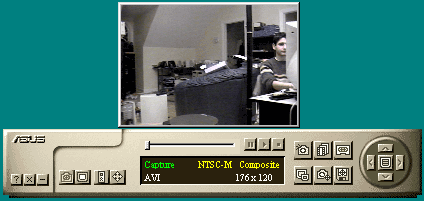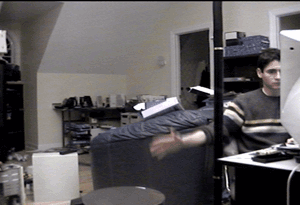Once again, due to the fact that the video features of the V6800 Deluxe are identical to the video features of the V6600 Deluxe (as the chips and layout are the same), the following except from our V6600 Deluxe review should provide insight into the capture functions of the V6800 Deluxe:
Of all the GeForce based cards on the market now, the ASUS V6600 Deluxe is the first one that we have seen with full video capture functions. How did the Philips SAA7113A video input processor perform in our capture tests? Well, the answer to that question is not easily answered.
ASUS packages their proprietary
ASUS Live software to handle most video in functions. Also included is Unlead's
Video Studio 3.0  software
that allows for MPEG-II software capture. The ASUS Live software program can
capture video still shots in BMP format and can capture video in only AVI format,
creating somewhat of a space hog, hence the need for Video Studio 3.0. We tested
the proprietary ASUS Live software to get a grasp on what the card can do. The
easy to use program includes options for the average resolutions that most video
input cards can capture at: from 320x240 to 704x480. These resolutions provided
sufficient capture options, whether you wish to send an online video or make
a full motion movie. Upon first glance, the images inputted using our S-Video
from JVC Digital Video camera looked better than the Voodoo 3500 TV which often
suffered from poor colors, slight flickering and lower capture resolutions.
The video capture part of the card is able to capture at up to 30 FPS, qualifying
it as D1 resolution (full NTSC or full PAL resolution). The bundled ASUS Live
software allows you to change the frame rate which you capture at from 30 FPS
to lower preset values, saving valuable disk space when high FPS ratings are
not required. Another nice feature of the ASUS Live software working with the
V6600 Deluxe is the fact that it can capture at almost any resolution without
significant frame rate loss. Even at 704x480 with lots of motion, the number
of frames dropped on a 30 FPS capture turned out to be less than significant.
software
that allows for MPEG-II software capture. The ASUS Live software program can
capture video still shots in BMP format and can capture video in only AVI format,
creating somewhat of a space hog, hence the need for Video Studio 3.0. We tested
the proprietary ASUS Live software to get a grasp on what the card can do. The
easy to use program includes options for the average resolutions that most video
input cards can capture at: from 320x240 to 704x480. These resolutions provided
sufficient capture options, whether you wish to send an online video or make
a full motion movie. Upon first glance, the images inputted using our S-Video
from JVC Digital Video camera looked better than the Voodoo 3500 TV which often
suffered from poor colors, slight flickering and lower capture resolutions.
The video capture part of the card is able to capture at up to 30 FPS, qualifying
it as D1 resolution (full NTSC or full PAL resolution). The bundled ASUS Live
software allows you to change the frame rate which you capture at from 30 FPS
to lower preset values, saving valuable disk space when high FPS ratings are
not required. Another nice feature of the ASUS Live software working with the
V6600 Deluxe is the fact that it can capture at almost any resolution without
significant frame rate loss. Even at 704x480 with lots of motion, the number
of frames dropped on a 30 FPS capture turned out to be less than significant.
The real problem with the capture function for the V6600 Deluxe is not seen until a screen shot is taken or a movie is closely examined. Running at any resolution, 320x240 all the way to 704x480, lines were visible due to interlacing. Interlacing is a feature that is found in most non-computer video devices. Interlacing allows a device to draw only half the horizontal lines with each pass of the device's electron gun. Because an interlaced device refreshes only half the lines at one time, it can display twice as many lines per refresh cycle. While this feature provides clear pictures on a television, computer devices are non-interlaced to allow for faster reaction time. The V6600 Deluxe takes in these interlaced signals and then attempts to de-interlace them. In the Philips chip used in the card, this de-interlacing results in a sandwiched view of the frames: each frame contains two interlaced frames. The final product of this feature leaves much to be desired, as the resulting picture or video has mismatched horizontal lines when motion is present on the screen. While the average user will not see the lines when displayed back on a television, the lines are present and cannot be missed upon close examination of the AVI file or the captured bitmap file.
While this may seem like a significant downside to such a great card, keep in mind what ASUS is attempting to accomplish the V6600 Deluxe. Rather than target a select group with great video capture functions at a high price, ASUS chose to make a card and include a software bundle that is more of an additional feature to a great gaming card. This card is not meant for the professional video editor, rather ASUS added such features to entice more of the high end market and give hard-core gamers an additional toy to play with. This toying can include placing and editing home videos on the computer or sending videos online. The feature, however, is not to be used to edit with professional quality.











0 Comments
View All Comments